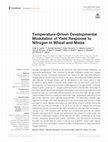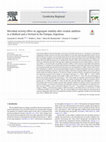Papers by Octavio Caviglia

Frontiers in Agronomy
Nitrogen management is central to the economic and environmental dimensions of agricultural susta... more Nitrogen management is central to the economic and environmental dimensions of agricultural sustainability. Yield response to nitrogen fertilisation results from multiple interacting factors. Theoretical frameworks are lagging for the interaction between nitrogen and air temperature, the focus of this study. We analyse the relation between yield response to nitrogen fertiliser and air temperature in the critical period of yield formation for spring wheat in Australia, winter wheat in the US, and maize in both the US and Argentina. Our framework assumes (i) yield response to nitrogen fertiliser is primarily related to grain number per m2, (ii) grain number is a function of three traits: the duration of the critical period, growth rate during the critical period, and reproductive allocation, and (iii) all three traits vary non-linearly with temperature. We show that “high” nitrogen supply may be positive, neutral, or negative for yield under “high” temperature, depending on the part o...

Geoderma Regional
Crop residue addition to the soil promotes an increase in microbial activity and, as a consequenc... more Crop residue addition to the soil promotes an increase in microbial activity and, as a consequence, may improve soil aggregate stability. However, this effect may be different in soils with contrasting aggregation agents. The aim of this study was to evaluate, in an incubation experiment, the role of microbial activity on soil aggregate stability after crop residue addition in two soils with contrasting clay mineralogy. Soybean and maize crop residues were added with three different frequencies on a Mollisol and a Vertisol, which were incubated during a 120-days period. It was studied the dynamics of soil aggregate stability after application of a fast wetting (MWD fw), slow wetting (MWD sw) and stirring after prewetting treatment (MWD st) which evaluates three different breakdown mechanism, i.e., slacking, microcracking and mechanical breakdown, respectively. Microbial activity dynamic was evaluated through measurements of soil respiration rate, microbial biomass-C (MBC) and hot-water extractable carbohydrate-C (HWEC). The Vertisol showed higher resistance to slaking (59% higher) but lower resistance to mechanical breakdown (92% lower) and microcracking (102% lower) than the Mollisol, with a scarce effect of residue quality and addition frequency. The discrete changes recorded in MWD fw throughout the experiment, were positively associated with changes in cumulative respiration (P < 0.001), MBC (P < 0.05) y HWEC (P < 0.05) in the Mollisol, and only with changes in MBC in the Vertisol (P < 0.05). Also, the small changes in MWD st were weakly and positively associated (P < 0.05) with changes in cumulative respiration in the Mollisol but not in the Vertisol. However, changes in MWD sw were closely associated with changes in cumulative soil respiration rate (P < 0.0001) and MBC (P < 0.001) in both soils, and with HWEC only in the Mollisol (P < 0.0001), with a higher effect on these variables than the other aggregate stability test. However, while in the Vertisol the increase in MWD sw as a function of cumulative soil respiration was lineal, in the Mollisol it was detected an evident increase in MWD sw up to a threshold of 500 μg C-CO 2 g soil −1 of cumulative soil respiration. Similarly, changes in MWD sw associated with changes in MBC were higher in the Mollisol than in the Vertisol (i.e. 0.018 v. 0.004 mm of MWD sw per unit of MBC). Thus, this research added new evidence about the contrasting role of transitory aggregation agents that are provided by microbial activity on aggregate stability in two contrasting soils such as a Mollisol and a Vertisol.










Uploads
Papers by Octavio Caviglia